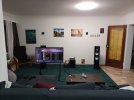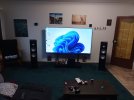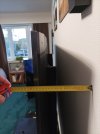kolestonin
Active Member
- Joined
- Jul 5, 2021
- Messages
- 263
- Likes
- 174
Speakers are Monitor Audio Silver 500 7G and the distance between them is 2,20cm. Distance from wall is 46cm.
I plan buying a big TV and while an 85’’ would make more sense given the viewing distance is 3,6m, I have concerns regarding the impact on sound. An 85’’ TV is 1,9m and that will bring it really close to the speakers. I also think it might be aesthetically overwhelming, or even having light reflections on the gloss of my speakers, but what I would like to know is if sound reflections to the screen can also be a problem.
Should I consider the 1,66 long 75’’? Or it will make no difference?
Maybe a projector, as their screen materials are more sound absorbing, is a better idea sound wise?
I would like to keep the speakers at current 2,20cm. I could put them a bit further away, but I don’t think I can do more than 2,30cm.
Reason I want to buy a bigger is TV is cause with my current setup I pass most of the time as can be seen in picture 2, with the TV acting as a sound barrier for my left speaker.
I plan buying a big TV and while an 85’’ would make more sense given the viewing distance is 3,6m, I have concerns regarding the impact on sound. An 85’’ TV is 1,9m and that will bring it really close to the speakers. I also think it might be aesthetically overwhelming, or even having light reflections on the gloss of my speakers, but what I would like to know is if sound reflections to the screen can also be a problem.
Should I consider the 1,66 long 75’’? Or it will make no difference?
Maybe a projector, as their screen materials are more sound absorbing, is a better idea sound wise?
I would like to keep the speakers at current 2,20cm. I could put them a bit further away, but I don’t think I can do more than 2,30cm.
Reason I want to buy a bigger is TV is cause with my current setup I pass most of the time as can be seen in picture 2, with the TV acting as a sound barrier for my left speaker.



